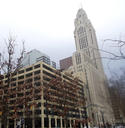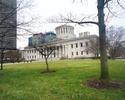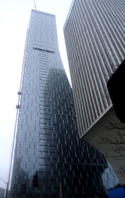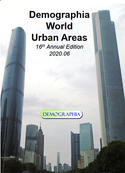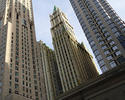The latest complete American Community Survey (ACS) data, analyzed by the Demographia City Sector Model, indicates that population growth in the nation’s 53 major metropolitan areas (over 1,000,000 residents) continues to be, even before the pandemic, overwhelmingly suburban and exurban. read more »
City Sector Model
Latest Data Shows Pre-Pandemic Suburban/Exurban Population Gains
- Login to post comments
Can Ford's Urban Gambit Survive Pandemic?
Ford Motor Co. unveiled grand plans this week to enhance its investment in the Corktown precinct of Detroit, envisioning creation of a 30-acre “mobility innovation district” around the iconic but crumbling Michigan Central train station that the automaker is restoring to make a hip urban locale for 2,500 engineers and tech people. read more »
- Login to post comments
Hangzhou: The Evolving Urban Form
Hangzhou is the capital of Zhejiang Province in China. Hangzhou’s historic core is located approximately 160 kilometers (100 miles) southwest of Shanghai and approximately 1,100 kilometers (675 miles) from Beijing .It is the largest municipality in Zhejiang, having passed Wenzhou within the last decade. read more »
- Login to post comments
Poor City, Rich Suburb: A Defining Characteristic of the Rust Belt
We all know that for decades the suburbia narrative was one of homogenized, sprawled and insulated wealth separated from diverse, dense and isolated poverty. We also know that's changed dramatically over the last 30-40 years. But that distinction really first became codified in the development patterns of cities that boomed in the late 19th/early 20th century: coincidentally, when Rust Belt cities boomed. read more »
- Login to post comments
Efficiency and Effectiveness in Ohio Townships
For decades, political interests and academics have proposed measures to require consolidation of local governments under the assumption that “bigger-is-better,” and that larger governments are inherently more efficient. Often such initiatives equate efficiency with a smaller number of governments. The data indicates otherwise. read more »
- Login to post comments
The Pre-Pandemic Rise of Working from Home (Telework) and Beyond
The 2019 market share data has just been released by the American Community Survey. Looking at driving alone and transit market shares, there has been virtually no change since 2010, with driving alone accounting for about three-quarters of commuting, while transit remains steady at 5%. The big news before Covid: the increase in people usually working from home (also referred to as telework or telecommuting) read more »
- Login to post comments
CSY Repost: The Community and Economic Development Hierarchy
I've spent many, many years of my career working to improve the economic development prospects of communities. Wanting to make a meaningful, positive contribution to the revitalization of cities is what pushed me into this career path. More to the point, I've spent a good deal of that time working in places that were facing stiff economic headwinds working against them. read more »
- Login to post comments
The Challenge of Revitalizing Urban Boulevards
One of the toughest challenges in real estate is revitalizing urban boulevards. There are dozens of plans for remaking these, but very few of these plans have actually sparked much private investment back of the curb line, and the reason is that in most cases these streets are simply so big and busy that people don't want to live or shop along them. It's time to use a new strategy, one of building at right angles to them, and of re-attaching underused land to the surrounding neighborhoods. read more »
- Login to post comments
Demographia World Urban Areas, 2020: Tokyo Lead Diminishing
For the first time in more than six decades the world’s second ranked built-up urban area has reached within 10% of leader Tokyo. The 2020 edition of Demographia World Urban Areas reports that Jakarta has reached a population of 34.5 million, behind Tokyo-Yokohama’s 38.0 million (Figure 1). The report can be downloaded here (Note 1). read more »
- Login to post comments
Employment by CIty Sector, Challenges Ahead for Downtowns
New Census Bureau employment data indicates that most job creation in the nation’s 53 major metropolitan areas (over 1,000,000 population) continues to be in the suburbs and exurbs. This article describes employment (job) locations by urban sector, using the City Sector Model (described in the Note Figure 4, below). The source of the data is “County Business Patterns, which is published annually for every zip code in the nation, which is unlike the American Community Survey, which uses a five-year period to cover all areas of the nation. read more »
- Login to post comments
